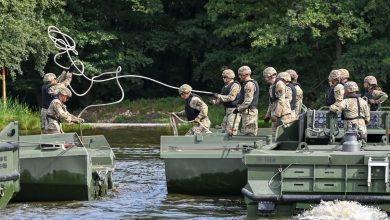Here are the major defense programs backed in shutdown-ending deal

The bills passed last week as part of the deal that ended the longest U.S. government shutdown in history include billions of dollars for major Air Force and Navy programs.
This includes funds to build new aircraft carriers and submarines, facilities needed for new stealth bombers and nuclear missiles and research and development spending to keep a major airborne command and control program alive.
The Continuing Appropriations Act of 2026 includes up to nearly $200 million in Air Force research and development for the E-7 Wedgetail program, in an effort to keep its rapid prototyping efforts on track and help it stay on schedule to transition to production.
It also shifts another $200 million from unobligated Air Force aircraft procurement funds to the E-7, bringing the Wedgetail’s total spending boost to almost $400 million.
The spending would keep the E-7 program alive, despite the Pentagon’s efforts to kill the Boeing-made airborne battle management aircraft as part of the 2026 funding process.
The Air Force initially moved to buy a fleet of up to 26 E-7s to replace its aging fleet of E-3 Sentry Airborne Warning and Control System planes, and in 2024 awarded the U.S. aerospace giant a $1.2 billion contract to start work on them. Australia, Turkey and South Korea already fly the E-7, but the Air Force wanted additional features such as open mission system software and improved global positioning system and satellite communication capabilities.
In a June congressional hearing, Defense Secretary Pete Hegseth expressed skepticism of the E-7’s future utility and survivability, and instead touted space-based intelligence, surveillance and reconnaissance capabilities. Later that month, when the Pentagon’s budget proposal was released, the department said it planned to cancel the E-7 over delays, cost increases and concerns that it may be shot down in a contested environment.
The move to kill the E-7 drew pushback from some lawmakers and more than a dozen retired Air Force generals, who signed an open letter saying the Wedgetail is necessary for a future war and urging the Pentagon to change course.
The bill also boosts the Navy’s shipbuilding spending by more than $1 billion. That includes another $510.4 million for the Virginia-class submarine program and $150 million more for the carrier replacement program, the Navy’s effort to replace older Nimitz-class aircraft carriers at the end of their service lives with newer Ford-class carriers that are larger and more advanced.
Another bill passed alongside the continuing resolution, the Military Construction, Veterans Affairs and Related Agencies Appropriations Act, provides the Air Force nearly $600 million for projects related to the B-21 Raider, a nuclear-capable stealth bomber now being built by Northrop Grumman. That includes $378 million for B-21 facilities and flight simulators at Ellsworth Air Force Base in South Dakota and $127.6 million for B-21 facilities at Whiteman Air Force Base in Missouri.
Dyess Air Force Base in Texas would also get nearly $91 million for its own B-21 facilities. Rep. Jodey Arrington, R-Texas, chairman of the House Budget Committee, touted the boosted spending for the base as “the largest investment in Dyess history” and more than three times what the base received last year.
“These funds will directly support the B-21’s arrival and ensure Dyess remains the tip of the spear for America’s air arsenal,” Arrington said.
Ellsworth will be the first base to receive operational B-21s in years to come. And in September 2024, the Air Force announced Whiteman and Dyess would follow in receiving B-21s.
In September 2025, after the second test B-21 flew for the first time, the Air Force said it planned to launch major construction projects at all three bases in fiscal 2026.
The bill also provides $130 million to build a utility corridor at F.E. Warren Air Force Base in Wyoming that will be used for the LGM-35A Sentinel program.
Sentinel is a massive Air Force project to replace the nation’s arsenal of more than 400 Minuteman III intercontinental ballistic missiles, which can carry nuclear weapons. Those missile sites are spread out across the Great Plains region, connected by thousands of miles of utility corridors.
The Air Force and Northrop Grumman, the prime contractor for Sentinel, plan to upgrade the old, heavy copper cabling with modern fiber optic lines as part of this project. Air Force Global Strike Command’s website on the Sentinel program said F.E. Warren will need to acquire easements to install and maintain 910 miles of new utility corridors, and must install and maintain additional utilities in 1,611 miles of existing corridors.
Eglin Air Force Base in Florida would also receive $125 million to build F-35A facilities. That includes $50 million for a two-bay F-35 test hangar, $52 million for a maintenance hangar and $23 million for a squadron operations facility.
The Air Force’s total construction spending amounts to roughly $4 billion.
Stephen Losey is the air warfare reporter for Defense News. He previously covered leadership and personnel issues at Air Force Times, and the Pentagon, special operations and air warfare at Military.com. He has traveled to the Middle East to cover U.S. Air Force operations.







